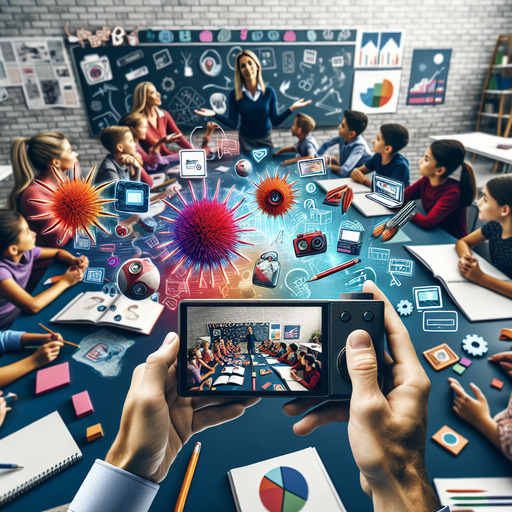
-
Table of Contents
Unlock the secrets to creating interactive educational videos that captivate and engage your students! Discover proven strategies and tools to make your lessons more dynamic and effective. [Learn more](https://www.dannyavila.com/)
Introduction
Creating interactive educational videos that boost student engagement involves a strategic blend of pedagogical techniques and multimedia tools. These videos are designed to actively involve students in the learning process, making the content more engaging and memorable. By incorporating elements such as quizzes, clickable links, and interactive simulations, educators can transform passive viewing into an active learning experience. This approach not only caters to various learning styles but also fosters a deeper understanding of the material. In this guide, we will explore the essential steps and best practices for developing interactive educational videos that captivate and educate students effectively.
How To Create Interactive Educational Videos That Boost Student Engagement
Creating interactive educational videos that boost student engagement requires a blend of thoughtful planning, creative execution, and the strategic use of technology. To begin with, it is essential to understand the target audience and their learning preferences. Knowing the age group, educational background, and interests of the students can significantly influence the content and style of the video. This foundational step ensures that the material is relevant and engaging from the outset.
Once the audience is clearly defined, the next step is to outline the educational objectives. Clearly stating what students should learn by the end of the video helps in structuring the content effectively. This can be achieved by breaking down complex topics into manageable segments, each with a specific focus. Transitioning smoothly between these segments is crucial to maintain a coherent flow and keep the students’ attention.
Incorporating interactive elements is a key strategy to enhance engagement. Interactive features such as quizzes, polls, and clickable links can transform a passive viewing experience into an active learning session. For instance, embedding short quizzes at the end of each segment not only reinforces the material but also provides immediate feedback, which is vital for effective learning. Additionally, using polls can gauge students’ understanding and opinions in real-time, making the learning process more dynamic and responsive.
Visual and auditory elements play a significant role in capturing and retaining students’ attention. High-quality graphics, animations, and sound effects can make the content more appealing and easier to understand. However, it is important to strike a balance; overly complex visuals or excessive sound effects can be distracting. Therefore, the use of multimedia should be purposeful and aligned with the educational objectives.
Another effective technique is to incorporate storytelling into the educational videos. Narratives can make abstract concepts more relatable and memorable. By presenting information through stories, educators can create an emotional connection with the students, which can significantly enhance engagement and retention. For example, explaining scientific principles through real-world scenarios or historical events can make the content more tangible and interesting.
Moreover, the pacing of the video is a critical factor. A well-paced video keeps the students engaged without overwhelming them with information. This can be achieved by varying the tempo of the presentation, incorporating pauses for reflection, and summarizing key points periodically. These techniques help in maintaining a steady flow of information and allow students to process and absorb the material effectively.
In addition to these strategies, leveraging technology platforms that support interactive features can greatly enhance the effectiveness of educational videos. Platforms like Edpuzzle, Nearpod, and H5P offer a range of tools to create interactive content, track student progress, and provide personalized feedback. Utilizing these platforms can streamline the process of creating and delivering interactive educational videos, making it easier for educators to focus on content quality and student engagement.
Finally, gathering feedback from students is essential for continuous improvement. Encouraging students to share their thoughts on the video content, format, and interactive elements can provide valuable insights. This feedback can be used to refine future videos, ensuring they are more aligned with students’ needs and preferences.
In conclusion, creating interactive educational videos that boost student engagement involves a combination of understanding the audience, setting clear objectives, incorporating interactive and multimedia elements, using storytelling, pacing the content effectively, leveraging technology, and continuously seeking feedback. By thoughtfully integrating these components, educators can create compelling and effective educational videos that not only engage students but also enhance their learning experience.
Q&A
1. **Question:** What are some key strategies for creating interactive educational videos that boost student engagement?
**Answer:**
– **Incorporate Quizzes and Polls:** Embed questions and polls throughout the video to keep students actively engaged and to assess their understanding in real-time.
– **Use Interactive Timelines:** Allow students to navigate through the content at their own pace, revisiting sections as needed.
– **Include Clickable Elements:** Add clickable hotspots that provide additional information, resources, or links to related content.
– **Gamify the Experience:** Integrate game-like elements such as points, badges, and leaderboards to motivate and engage students.
– **Utilize Storytelling:** Craft a compelling narrative to make the content more relatable and memorable.
– **Provide Immediate Feedback:** Offer instant feedback on quizzes and activities to help students learn from their mistakes and reinforce correct answers.
– **Incorporate Multimedia Elements:** Use a mix of visuals, audio, and text to cater to different learning styles and keep the content dynamic.
– **Encourage Peer Interaction:** Facilitate discussion and collaboration through comments, forums, or group activities linked to the video content.